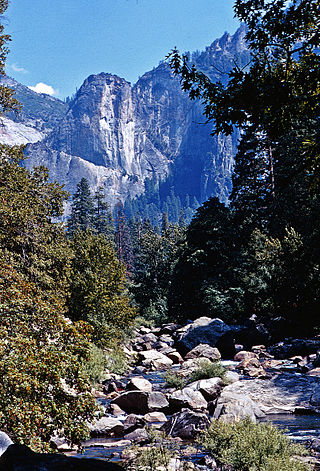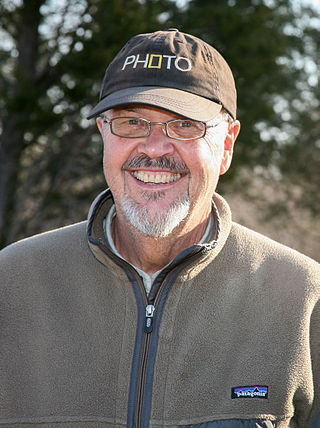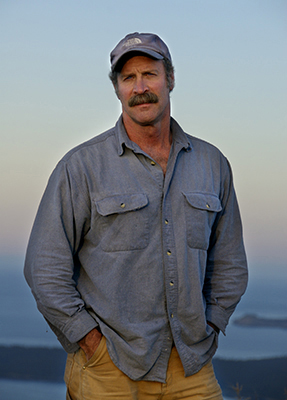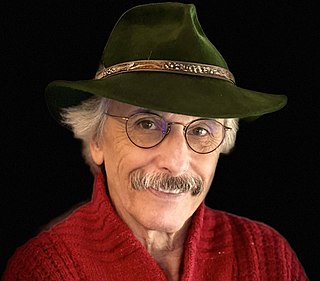
Ansel Easton Adams was an American landscape photographer and environmentalist known for his black-and-white images of the American West. He helped found Group f/64, an association of photographers advocating "pure" photography which favored sharp focus and the use of the full tonal range of a photograph. He and Fred Archer developed a system of image-making called the Zone System, a method of achieving a desired final print through a technical understanding of how the tonal range of an image is the result of choices made in exposure, negative development, and printing.
Galen Avery Rowell was a wilderness photographer, adventure photojournalist and mountaineer. Born in Oakland, California, he became a full-time photographer in 1972.
The WILD Foundation is a 501(c)(3) organization that was founded in 1974 by two South Africans and based in Boulder, Colorado.
Philip Hyde (1921–2006) was an American landscape photographer and conservationist. His photographs of the American West were used in more environmental campaigns than those of any other photographer.

Hugo Arndt Rodolf, Baron van Lawick was a Dutch wildlife filmmaker and photographer.
David Muench is an American landscape and nature photographer known for portraying the American western landscape. He is the primary photographer for more than 60 books and his work appears in many magazines, posters, and private collections.
Robert Glenn Ketchum is pioneering conservation photographer, recognized by Audubon magazine as one of 100 people "who shaped the environmental movement in the 20th century.".
John Fielder was an American landscape photographer, nature writer, the publisher of over 40 books, and a conservationist. He was nationally known for his landscape photography, scenic calendars and for his many coffee table books and travel guides—including Colorado's best-selling Colorado 1870–2000, in which he matched the same scenes of classic photographs taken in the 19th century by photographer William Henry Jackson.

Documerica was a program sponsored by the United States Environmental Protection Agency to "photographically document subjects of environmental concern" in the United States from about 1972 to 1977. The collection, now at the National Archives, contains over 22,000 photographs, more than 15,000 of which are available online. The title is a portmanteau of "documentary" and "America".
David Rains Wallace is an American writer who has published more than twenty books on conservation and natural history, including The Monkey's Bridge and The Klamath Knot. He has written articles for the National Geographic Society, The Nature Conservancy, the Sierra Club, and other groups. Wallace's work also has appeared in Harper's Magazine, The New York Times, Sierra, Wilderness and other periodicals.

Conservation in the United States can be traced back to the 19th century with the formation of the first National Park. Conservation generally refers to the act of consciously and efficiently using land and/or its natural resources. This can be in the form of setting aside tracts of land for protection from hunting or urban development, or it can take the form of using less resources such as metal, water, or coal. Usually, this process of conservation occurs through or after legislation on local or national levels is passed.
Robert C. Birkby is an American adventure guide, author, photographer, speaker and trail designer.

Conservation photography is the active use of the photographic process and its products, within the parameters of photojournalism, to advocate for conservation outcomes.
Amy Gulick is an American nature and wildlife photographer. She is one of the founding Fellows of the International League of Conservation Photographers

Jack William Dykinga is an American photographer. For 1970 work with the Chicago Sun-Times he won the annual Pulitzer Prize for Feature Photography citing "dramatic and sensitive photographs at the Lincoln and Dixon State Schools for the Retarded in Illinois."

George Beals Schaller is an American mammalogist, biologist, conservationist and author. Schaller is recognized by many as the world's preeminent field biologist, studying wildlife throughout Africa, Asia and South America. Born in Berlin, Schaller grew up in Germany, but moved to Missouri as a teen. He is vice president of Panthera Corporation and serves as chairman of their Cat Advisory Council. Schaller is also a senior conservationist at the Bronx Zoo-based Wildlife Conservation Society.

Harold Davis is an American photographer and author.

Carr Clifton is a local American landscape, nature and wilderness photographer. A native Californian living in the northern Sierra Nevada near Taylorsville, California, Carr began photographing and color printing professionally in 1979 after seeking advice and inspiration from his mentor and neighbor, pioneering 20th century master landscape and conservation photographer Philip Hyde. Credits include a US Postal Service stamp of Acadia National Park and numerous exhibit format books. Clifton has spent thirty-five years exploring and documenting endangered, wild landscapes, creating an immense body of work with a large format 4x5 film camera, and more recently a digital camera.

Kim Heacox is an American author, photographer, musician, and environmental activist living in Gustavus, Alaska, at the entrance to Glacier Bay National Park. He was born in Lewiston, Idaho and grew up in Spokane, Washington. Heacox is best known for two of his books, The Only Kayak, a memoir, and Jimmy Bluefeather, a novel (2015), both winners of the National Outdoor Book Award, and for his opinion pieces in The Guardian that focus primarily on the climate crisis, global biodiversity loss, and threats to U.S. public lands. His most recent book, On Heaven’s Hill, is a literary novel author Kimi Eisele praised as “the kind of story the planet needs right now.”
Thomas D. Mangelsen is an American nature and wildlife photographer and conservationist. He is most famous for his photography of wildlife in the Greater Yellowstone Ecosystem, as he has lived inside the zone in Jackson, Wyoming, for over 40 years. In 2015, he and nature author Todd Wilkinson created a book, The Grizzlies of Pilgrim Creek, featuring a grizzly bear known as Grizzly 399, named so due to her research number. He has been active in the movement to keep the Yellowstone area grizzly bears on the Endangered Species List. Mangelsen is also known for trekking to all seven continents to photograph a diverse assortment of nature and wildlife. A photograph he took in 1988 titled, "Catch of the Day" has been labeled "the most famous wildlife photograph in the world". In May 2018, he was profiled on CBS 60 Minutes. He has received dozens of accolades throughout the decades.



















